Description
ChessBase 17
ChessBase is a personal, stand-alone chess database that has become the standard throughoutthe world. Everyone uses ChessBase, from the World Champion to the amateur next door. It is the program of choice for anyone who loves the game and wants to know more about it. Start your personal success story with ChessBase and enjoy the game even more.
WHAT YOU CAN DO WITH CHESSBASE: Retrieve games according to openings, players and tournaments; generate tournament cross tables and full graphic statistics of players or openings; “Similarity search” shows all games with similar pawn structures, sacrifice patterns, endgame positions, etc.; “Let’s check”*: access the world’s largest database of in-depth analysis (more than 200 million positions); “Instant Analysis”: Any unannotated game is analysed almost without delay immediately on loading (optional). “Assisted Analysis”: as you enter a game, whenever you click on a piece an evaluation is produced for all its possible target squares; “Tactical Analysis” will annotate game, inserting commentary, variations and diagrams, before strong moves or errors, into a game or an entire database. It will also point out combinations, played in the game or missed, tries, attacks, initiative, and of course the latest in openings theory; Cloud analysis: you can analyse positions simultaneously with several engines from on di©erent computers running in parallel; “Deep analysis”: generates an analysis tree that changes dynamically, as with time weaker variations are dropped; automatic analysis jobs for correspondence games; “Replay Training”: Playing through a game with the notation hidden and automatic training questions with tips for each individual move. Extended reference search for openings shows increase/decrease in popularity and typical recurring endgames; merge games on the fly into an opening tree; Repertoire recommendations for every move with a single click; generate a dossier containing all available information on a specific player from the database; Preparation for opponents with recognition of their weaknesses; generate a comprehensive openings report with main and critical lines, plans and most important games; Urgent news about recently played innovations; Search for characteristic tactical positions in an opening variation single click publication of games on the Internet; Improved search mask with tactical motifs and examples for manoeuvres and material distribution; Completely new search booster for patterns and plans; print games in superb quality with diagrams and multiple columns; Crisp new 3D boards thanks to raytracing technology; automatic update of your local reference database with the weekly installments of games (one year); access to the ChessBase online database with over eight million games*, mobile access with the ChessBase Account
The most important innovations
ChessBase 17 focusses at things that, in our view, are the foremost of the program's areas of application. First of all, a lot of work has gone into functions that one only notices subconsciously, but which improve the user experience: the new ultra-high-resolution 2D board; the really crisp display of notation and lists through support of Direct 2D which runs on all recent Windows versions; and popular in more recent times: the "Dark Mode".
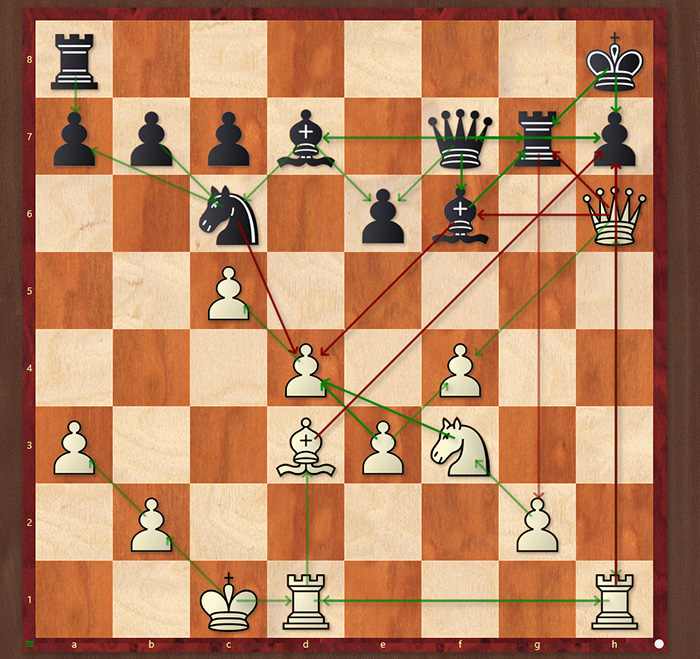
Technical improvements
Then there are many technical improvements that generally improve the program, such as: a new faster data format, with fewer files and no search booster - which overcomes limitations of the CBH format; and a fine-tuning of the database paths that solves conflicts with the Documents directory and OneDrive, so you can smoothly manage your databases outside the standard Windows directories.
Interactive search mask and much more
The smart inputting of positions is of direct chess significance. You place a few pieces onto the board, and immediately see in which games of the reference database this position fragment occurs. By clicking on a game, you can save yourself the rest of the inputting. The new search mask is also more interactive: if you enter a search criterion, the number of games in the database for which it matches is immediately displayed. This way, you know what yield to expect before you click on "OK".
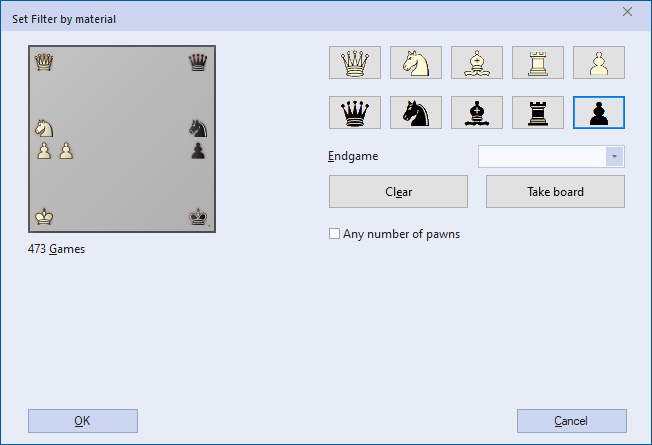
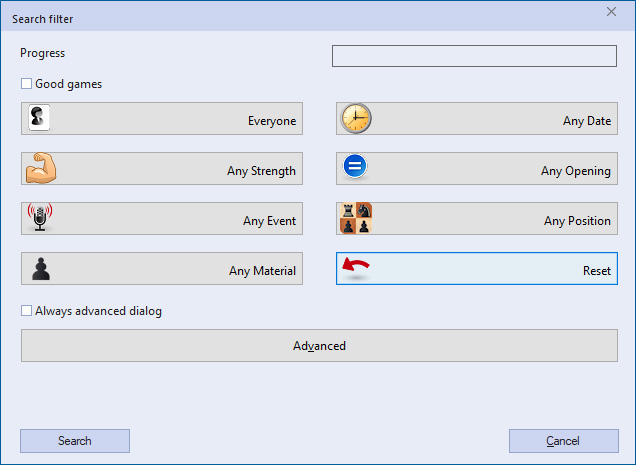
interactive searchmask
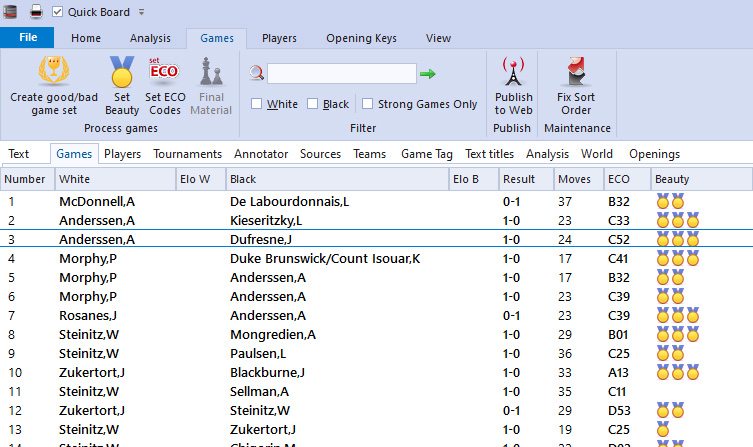
Pearl search: Find spectacular games instantly!
The new engine window
A lot has also been done in an area that is crucial for daily chess work: the engine window. Most ChessBase users probably spend 90% of their time with interactive analysis of positions. The output of engines has altered little in the last 30 years: variations, evaluations, dry as dust, done. In ChessBase 17, this has been fundamentally re-evaluated. The visual evaluation of pieces and measurement of complexity - you know from Fritz 18. The display of non-trivial threats or temptations is fancy, but also already familiar. The same goes for the training option to suppress the entire engine output, and only receive subtle tips as a stimulus to your own thinking. This is primarily intended for when watching live games.

Analysis in natural language
However, the interpretation of an engine variation in natural language is groundbreakingly new. It is often a challenge for many players to imagine what is actually happening based on just an engine variation. You see the best move, the rating, and that's it. ChessBase 17 describes in words what the variation entails
For example: In a super-sharp position, a complex variation has the strange rating "0.00". ChessBase 17 would then add "perpetual check" or "repetition of the position" and the situation would become clear. Material changes are vividly described: "White wins the queen for rook and knight"; "Black loses two pawns"; and even "The position is simplified into an endgame R+B vs R+N". There are also exciting statements like: "White gains a dangerous passed pawn on e6"; or "White sacrifices a bishop"; "Black has an attack"; "White gets the majority on the kingside"; "Both kings are insecure"; and "Manoeuvre Nd2-f1-e3-d5" etc.
Such assertions clarify the motives behind a position. If you want to understand even more of what the program means by these hints, simply move the mouse over the move indicated and the position appears on the main board. Clicking on a move copies the variation up to that move into the notation, which then simplifies the commentary
“The more colourful, the sharper” - or "Death to the exclamation mark!"

It does make a di'erence whether a position contains sharply forced variations, or several moves of almost equal value. Today's engines do not provide this information. ChessBase 17 therefore diverts a small part of the hardware resources towards a clone of the main engine, and calls this the "Buddy engine" - this only slightly impacts the computing power of the main engine. Buddy now goes over the variations, and analyses the position after each move. The variations are saved so that you can easily view them by moving your mouse cursor over on the move. Importantly, forced moves are annotated with coloured rectangles. The exclamation mark used in commenting on games for 170 years, doesn’t do justice to Buddy's search results; therefore, we now only use it for sacrifices
The colour of the rectangles indicates the evaluation. The shape shows from which depth the forcing is recognised in the calculation. Trivial tactics have vertically divided rectangles. Medium forcing divides the rectangle into two triangles from top left to bottom right. Deep forcing divides diagonally from right to left. If the upper (or left) part is green, the move wins. If the lower part is yellow, for example, the position remains roughly in the draw range after the worse alternative move. If it is red, the alternative move loses. This system may seem complex at first glance, but it has the advantage that a lot of information is signalled in one space-saving symbol. The exclamation mark has had its day. In any case, one thing is clear: the more colourful, the more forcing!
For years, we have recommended analysing with two engine variations, so that at least one forced main move can be recognised immediately. However, this costs a lot of additional computing time. ChessBase 17 marks the beginning of a renaissance of single-variation analysis. At the same time, the calculation goes much deeper. Buddy shows whether the first move is forced, and also provides the second variation.
New in ChessBase 17:
- New data format: fewer files, more functions, more comfort, more speed.
- Engine analysis renovated: Variants are automatically verbally annotated, forced continuations are recognized, “buddy heuristics” for greater search depth!
- Pearl search: Find spectacular games instantly! Beautiful games are marked in the database list.
- Optimised program interface: high-resolution 2D board, faster graphics.
- New clearer search mask: material & positional searches simplified, immediate feedback on expected results.
- Intelligent position input: when setting up pieces, you are shown the games where those positions occur.
- Dozens of detail improvements for improved usability, e.g. automatic loading of the last edited game.
- Control via One-Drive: all database paths can be set in the options dialogue.
- Newly structured game notation: with intelligent folding and symbols.
- Modern integrated browser for all database texts.
- More insight: Visualisation of attack correlations (optional).
- Dark Mode: darkened program interface.
*) Access via PREMIUM ChessBase Account
Fritz 19
Attacker, coward, swindler or endgame wizard: I'll show you how to win against anyone! After my World Championship victories in 2022 and 2023, I am the reigning Chess Software World Champion and am now looking forward to showing you how to become even stronger against your opponent With my innovative training method, I simulate typical player personalities you know from tournaments and online chess: brash attackers, cautious cowards, passive players. But how do you win against them? Fritz will show you how! And for beautiful attacks, combinations or sacrifices, there are the new ChessBase cards as a reward for you. Practical training that's also a lot of fun. Or let's train openings: you can try out a new repertoire ideas directly in a match against me. And how about the new calculation training for a quick Elo boost? As Fritz19 I can make you play better again.
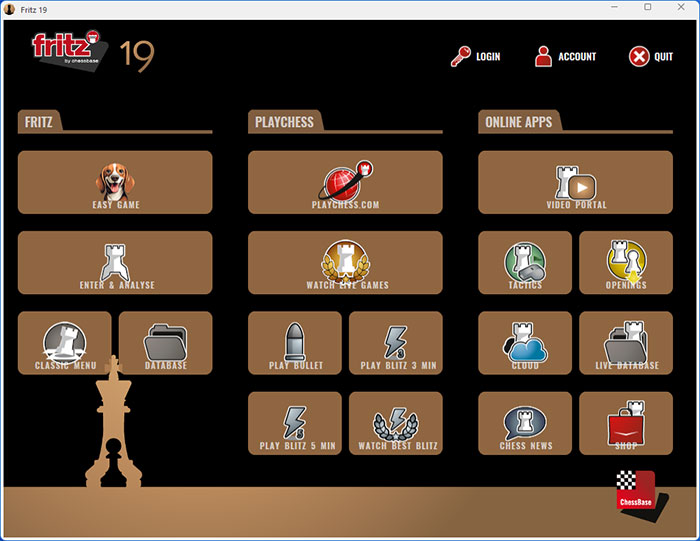
Fritz 18 marked the beginning of a new era, and Fritz 19 drives this development onward: a game against Fritz should be more than just a game - it should be an experience. In a time when online chess dominates, a chess program has to oer something special to be a real alternative to human opponents.
In Fritz 19 it works like this
- There are six different characters that mimic typical club players: Allrounder, Aggressive, Positional, Swindler, Fearful, Endgame Expert.
- Fritz plays human moves that fit these types, but builds-in tactical mistakes so that you can win with a sacricial attack, for example. The sharper the position, the more likely the program will misstep.
- There is a wide range of tips and support that you can use to the full, or ignore, depending on your mood. With all the tips, you will practically always win against the “strong club player” level. If you ignore them completely, it becomes challenging for a player like me (ELO 2000).
- You can earn trophies for special moves that are converted into digital trading cards, such as “rook on the seventh rank”, “exchange sacrifice” or “mate threat”.
- At any time during the game, you can switch to “assisted calculation” mode. Where is no clock, so you can train your calculation without stress in positions you have played yourself. This has an enormous training benefit.
The opponent zoo
The character Allrounder is probably the strongest opponent for every level of play. It is a development of “Easy Game” from Fritz 18. Everyone knows the Aggressive Player from their club. They regularly play on the attack, with a sharp opening repertoire. They are the ideal opponent for defence training with Black. The Swindler takes aggressiveness to the extreme, and o!en overplays the position. Material and solid position are of no interest, the main thing is to go for the king. Against this swindling fox, one usually has a material advantage, but suddenly it becomes highly dangerous. The wise owl symbolises the Positional Player. It loves a good pawn structure, a secure king of its own and coordinated piece-play. e distorted echo of this, is the fearful mouse. It appreciates crowded, safe positions and is afraid of complications. That is why it often plays weaker. The Endgame Fan, on the other hand, plays specifically for exchange. Simplification is paramount, the opening is o!en unambitious. When it comes to the endgame, on the other hand, things get really tough. An effective training opponent for this phase of the game!
Collectible cards as a reward: Fritz 19 celebrates your good moves.
When playing against Fritz 19, you can acquire 136 dierent trophies. Some are quite simple, like Closed Centre or Bishop Pair. You will swi!ly grab them. Others don’t just happen by themselves: the advance of a passed pawn, a knight outpost, an unsafe opponent’s king position, space advantage or a sharp position. The crowning glory are trophies such as queen sacrifice, mate with knight, and many more. There is a ranking list for each of these trophies. That should be reward enough for chess players, but we have come up with something very special, the description of which would go beyond the scope of this article: Winning trophies is rewarded with the distribution of digital trading cards in your ChessBase account. Do you recall Panini sticker albums? Then you know the score.
New opening training
We all manage our opening repertoire in variation trees, stored in databases. If you want to play against it, it gets technical: opening books have to be converted. On today’s powerful computers, this has become obsolete. In Fritz 19, you play directly against databases, your own repertoire, or an opening article from the ChessBase Magazine!
If the White player, the Black player, the tournament title, or the source begins with “White” or “Black”, then all the moves in this game belong to this colour. Fritz will then only play these moves. A repertoire is always rather narrow from the point of view of one’s own colour and broad for the opponent’s moves. Try it out: Your Najdorf repertoire with Black against the “aggressive” player! Tip for ChessBase users: Save a generated opening survey from ChessBase and play against it immediately
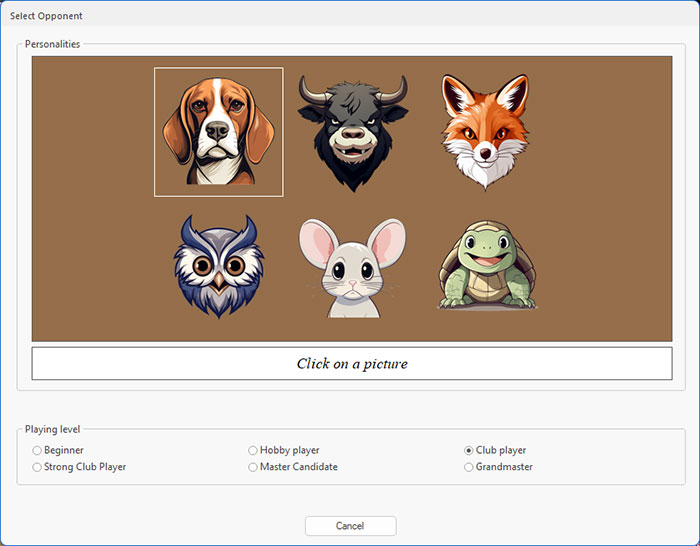
What else is available
The new engine in Fritz 19 is the Computer Chess World Champion for 2023. The Calculation Training has been extended, especially in the important preliminary query of candidate moves. The Buddy Engine and the annotated engine analysis from ChessBase 17 have found their way into Fritz. The notation (and the whole program interface) has been enormously enhanced in places. Tactical Analysis, the important full commentary of your games, has been improved and much more!
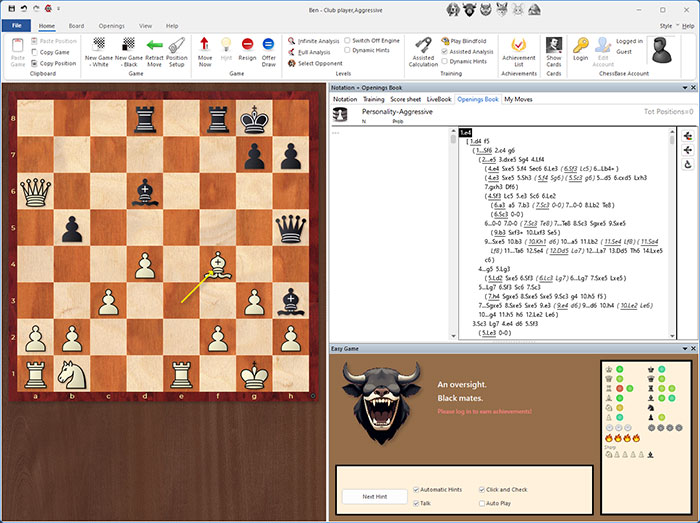
Payment & Security
Your payment information is processed securely. We do not store credit card details nor have access to your credit card information.


